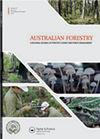Compression and flexural properties of plantation-grown Eucalyptus pellita in Borneo, Malaysia. Potential for structural timber end use
IF 1.2
4区 农林科学
Q3 FORESTRY
引用次数: 2
Abstract
ABSTRACT Plantation-grown Eucalyptus pellita in Sabah, Malaysia, was analysed for compression and flexural properties to assess the potential for solid-timber and engineered wood product end uses. It is necessary to consider not only the volume of wood produced in a plantation but also the wood quality, particularly those aspects important for end-product performance. Tree volume is readily measured from height and diameter at breast height using appropriate form factors. This paper discusses the compression, strength and stiffness of E. pellita compared with tropical hardwood species, and variation within trees and at different ages (7–23 years). Small clearwood test samples obtained from radial positions within log heights were subjected to analysis of compression parallel to grain and three-point bending according to ISO 13061-4, 2014. Results indicate that plantation-grown E. pellita in the tropics has potential for structural-use applications. The average basic density across the trials was 658 kg m−3, while the bending strength for all trials was in the range of 11.7–15.5 GPa for modulus of elasticity and 96.3−120.1 MPa for modulus of rupture, and the compression strength parallel to grain ranged from 52.3 to 67.8 MPa. Mean mechanical strength increased from pith to bark and from the butt log to the top log. Because the wood-processing sector in Malaysia is transitioning from reliance on a harvest of mixed tropical hardwood towards plantation-grown species, these results indicate that plantation-grown E. pellita meets the structural requirements of strength and stiffness.马来西亚婆罗洲人工林生长的糙皮桉的压缩和弯曲特性。潜在的结构木材最终用途
摘要分析了马来西亚沙巴种植的纯桉的压缩和弯曲性能,以评估其在实木和工程木产品最终用途方面的潜力。不仅需要考虑种植园生产的木材数量,还需要考虑木材质量,特别是对最终产品性能重要的方面。使用适当的形状因子,可以很容易地从身高和乳高处的直径测量树木体积。本文讨论了E.pellita与热带硬木物种的压缩、强度和刚度,以及树木内部和不同树龄(7–23岁)的变化。根据ISO 13061-4-2014,对从原木高度内的径向位置获得的小型透明木材试样进行平行于纹理的压缩和三点弯曲分析。结果表明,在热带种植的E.pellita具有结构应用的潜力。整个试验的平均基本密度为658 kg m−3,而所有试验的弯曲强度弹性模量在11.7–15.5 GPa范围内,断裂模量在96.3–120.1 MPa范围内,平行于晶粒的压缩强度在52.3至67.8 MPa范围内。平均机械强度从木髓到树皮以及从原木底部到顶部都有所增加。由于马来西亚的木材加工部门正在从依赖混合热带硬木的收获向种植园种植的物种过渡,这些结果表明,种植园生长的E.pellita满足强度和刚度的结构要求。
本文章由计算机程序翻译,如有差异,请以英文原文为准。
求助全文
约1分钟内获得全文
求助全文
来源期刊

Australian Forestry
FORESTRY-
CiteScore
3.70
自引率
4.80%
发文量
15
审稿时长
>12 weeks
期刊介绍:
Australian Forestry is published by Taylor & Francis for the Institute of Foresters of Australia (IFA) for scientific, technical, and professional communication relating to forestry in the Asia Pacific.
 求助内容:
求助内容: 应助结果提醒方式:
应助结果提醒方式:


